I’m going to take you through, step by step the exact SaaS SEO roadmap that we use for businesses that have an existing base of content and landing pages and how we take those and optimize them to drive an organic bump in demos and trial signups.
If you’re a founder or a marketing leader who’s been struggling to drive a surge in organic conversions and you’ve run out of past SEO initiatives before, then, this article and video is for you.
I’m going to walk you through everything you need to do in order to boost organic conversions for your business.
Let’s dive in.
Prefer to read along instead of watching the video video? Check out the video transcript below.
I want to kick off our roadmap by talking a little bit first about priority and why I think that priority is key.
Priority is key because basically the actions and the effort that we put in are what’s going to determine the output:
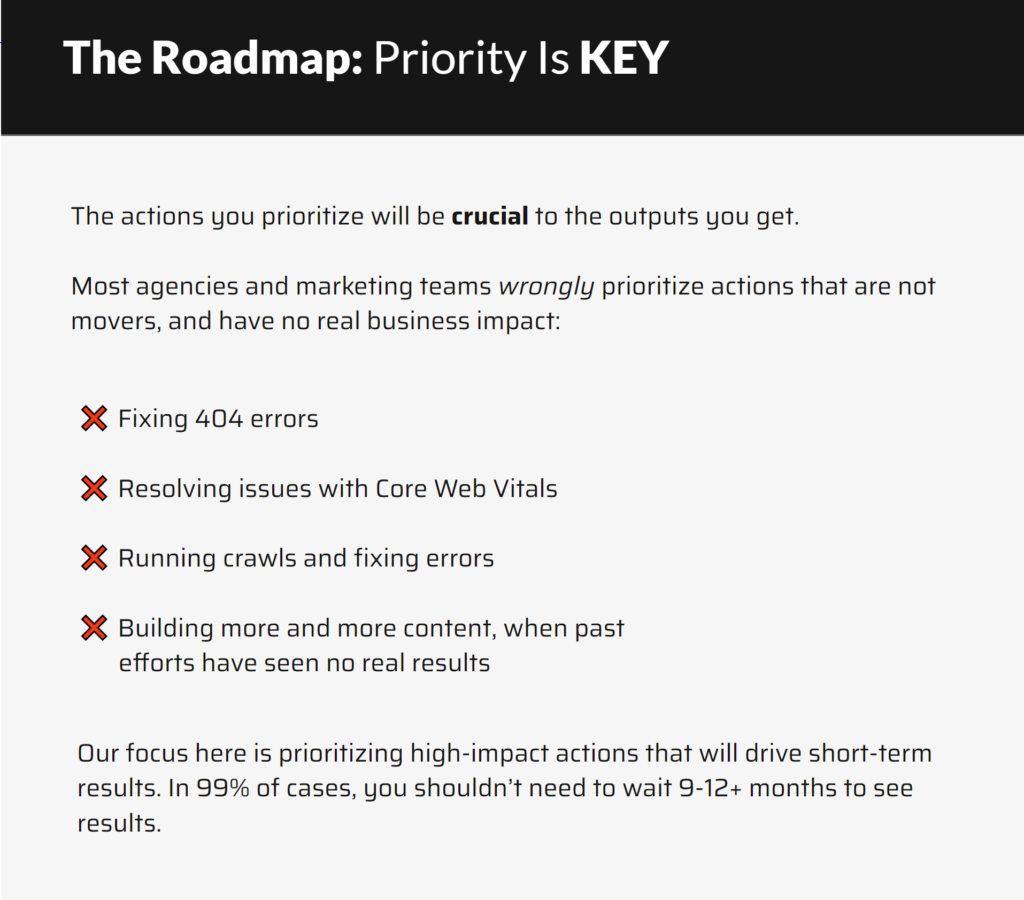
It’s specifically what we do, the changes we make, and whatever we create that is going to have an impact potentially on our organic performance or not.
And the one thing that I see over and over again with in-house teams, and marketing agencies is that they unfortunately oftentimes prioritize actions that based on the stage where the company is at or even sometimes irrelevant, those actions will have really no actual measurable impact on organic performance and conversions.
Common examples of those are fixing 404 errors or resolving issues with core web vitals running crawls fixing errors from tools like SEMrush or building more and more and more content when past efforts have really driven no actual measurable business results.
Doing these things, in my opinion, they’re usually not what’s going to move the needle.
Our focus here is we want to prioritize high-impact actions that are going to drive results in the short term because you only probably have so much time to get results from these actions.
And in 99% of cases you shouldn’t have to wait 12+ months to see results because it always comes down to the actions, what you’re prioritizing.
Basically how fast you’re running. This is the exact basic roadmap theory you’re using for essential clients that we work with that fit into a particular bucket.
Potential clients that are typically a great fit for this roadmap, have an existing base of pages and content, but maybe they have just been struggling to generate MRR growth.
They’re kind of stagnant, organic growth is stuck, maybe slightly declining.
Another good example is they have a strong backlink profile. So you’re not starting from scratch in many cases. Probably not your first SEO initiative, right?
You’ve done past initiatives to try to drive growth.
You’re ready to make changes that will have a real business impact. You’re actually ready to listen to and implement these changes. That’s obviously a big one because if we don’t act well, we can’t get actual output.
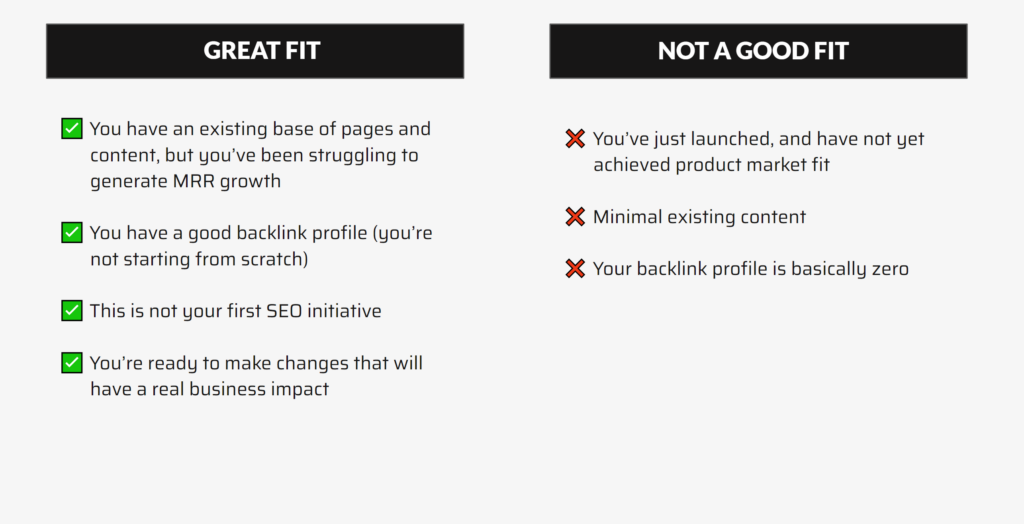
Those that are typically not a good fit:
So if you fall into this category, into this bucket, what I’m going to go over in the rest of the videos is probably not going to be helpful at the stage you’re at.
But for the purpose of this video, I want to focus on companies that really fall into the first bucket and that will really benefit from following this roadmap.
The first action on our list is the first thing that we do when working with any client.
We get it in a crawl of the entire website.
We’re essentially looking at what pages are indexed and living in Google so that we can start to potentially eliminate and no index, aka remove pages from Google’s index that are not hyper-relevant to the product and solution that that business provides.
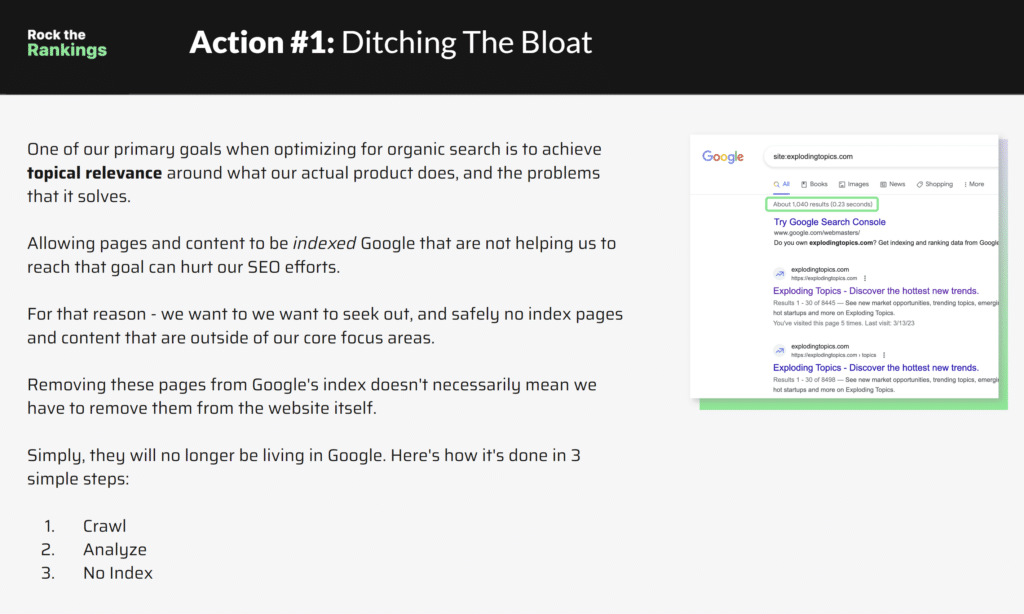
And this goes back to kind of the theme and topic around achieving topical authority and topical relevance to the core pains and problems that your product solves.
Basically only allowing pages to be indexed in Google that are really targeted towards helping with our SEO efforts.
For that reason, anything not built for Google, built for search engines, not built to rank and drive qualified website visitors, we simply want to remove it from Google.
That’s the core idea of what we’re trying to achieve here.
On the right-hand side, I have an example from Exploding Topics.
Our team worked with Brian Dean, the co-founder over at Exploding Topics, who formerly was the founder of Backlinko.
I think this was kind of an eye-opening moment for me years ago when we worked with Exploding Topics.
The objective was we’re trying to no-index roughly 4000 pages from Google’s index and the entire idea was we only want specific pages that are built to rank in search.
So really the goal and idea here is can we remove pages that are filter pages?
Pages like categorized by past six months, past year, and past two years, there are pagination issues, other content, and pages that were just getting indexed and getting added to Google that have no reason to be there.
And what really surprised me about this at the time was the organic performance bump that we saw from doing this.
And again, this was years ago.
Since then we’ve been doing this consistently for all of our clients, and we still see direct organic impact from doing so.
No indexing content really solidified in my head the importance around we want to keep the index of Google and other search engines super, super clean. And the process of really resolving this is three simple steps.
This is something you can directly see manually, for example, within Google search console.
If you go to pages over on the left-hand side you click view data about index pages and you scroll down, this will tell you and give you a list of all the pages that are currently indexed within Google as well as you can also see below that pages that are not indexed and the reason why:
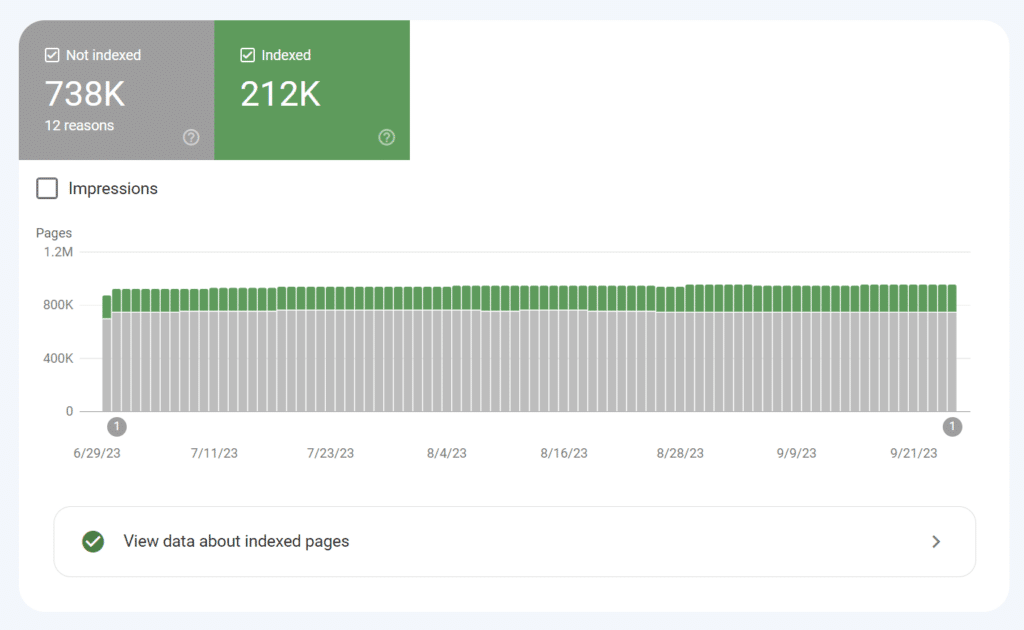
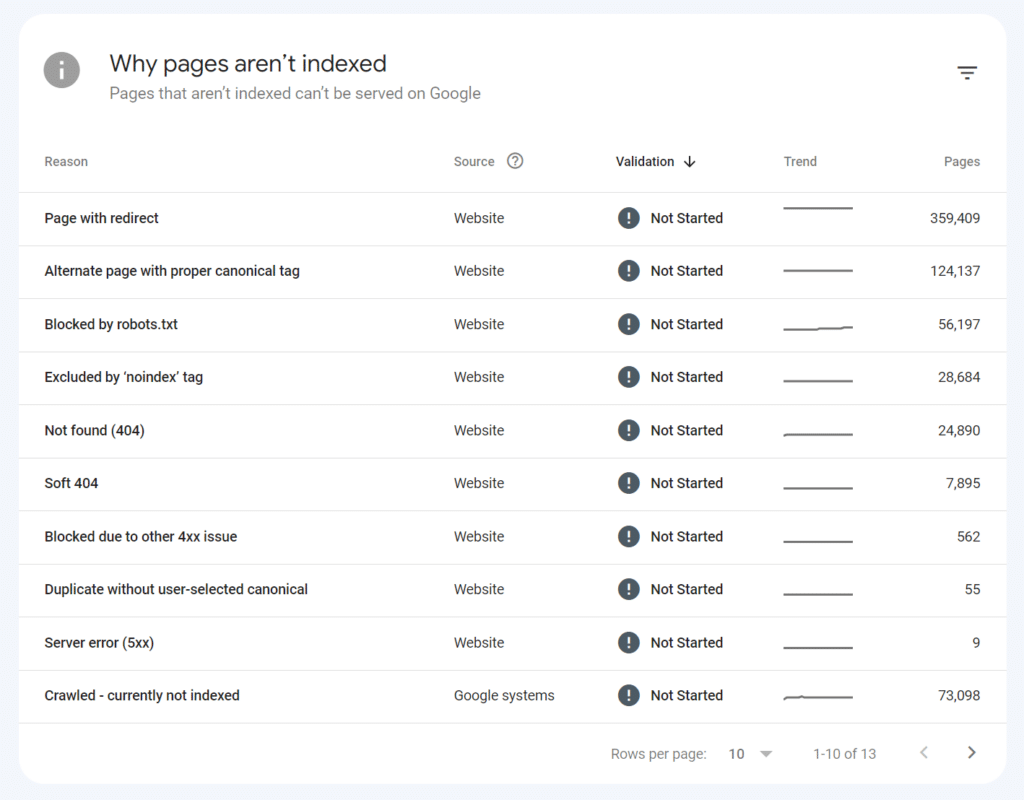
We want to come up with an aggregate list and again, anything that has no purpose of living in Google, we simply want to remove it using a no index.
Adding a no index doesn’t mean it doesn’t need to live on the website anymore.
It most certainly can. It can still be visible by users navigating the website itself.
Users can still see it on the website, but we’re simply pulling it out of Google’s index.
That’s really the core idea of how we can focus on ditching the so-called index bloat.
So that’s always action number one.
Action number two is always simple- we want to go and buff up our so-called product pages.
Product pages would be considered as our features and benefits pages use cases pages, and those individual landers that we set up that we typically attempt to map back against specific high-intent queries.
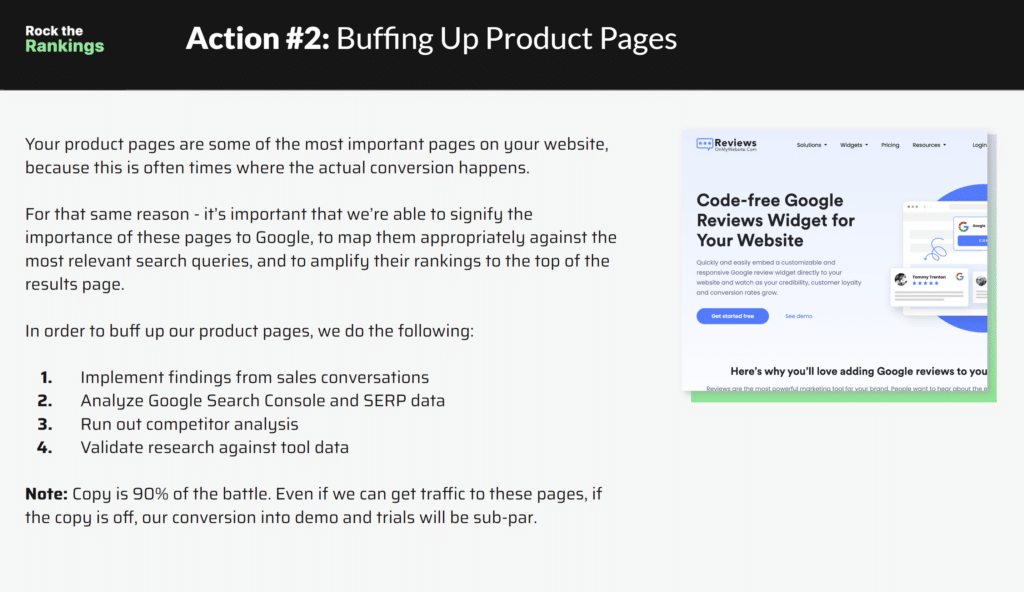
We want to go through those pages because they’re extremely important from the conversion perspective, right?
Normally you’re running paid ads to these pages.
From an organic perspective, of course, we’re mapping these back against high-intent search terms for those that are solution-aware and are specifically looking for a certain solution in the search results.
The goal here is we want to be able to signify the importance of these pages, right?
We want to map them back against the relevant high-intent search queries, and we want to be able to amplify their rankings to push them to the top of the search results.
I want to say even before I dive into these product pages, copy is 90% of the battle.
Copywriting should be the driver of the actual content that lives on these pages. Because even if we can get these pages to rank and the copy and message is off, we’re not speaking to pains, we’re not speaking to problems, we’re not showcasing a desired outcome.
That’s great if they can rank, right? That’s great if we’re in a position number one.
But if nobody’s converting, that’s the real metric that matters.
So I want to really bring that point to the surface that copy is extremely important for our product pages.
How do we actually buff these pages up?
Well, first of all, we want to implement findings from sales conversations, from customer success conversations.
Directly from being involved in those conversation recordings, there are learnings there in terms of the type of language we should be using, the pain, and problems we should be focused on.
That is how we want to really lay out the majority of the content and structure on these pages. And once we have that vital information, then we can dive into things like, okay, well, let’s analyze Search Console for this existing product page, let’s pull back other secondary terms that it ranks for and build those naturally into the copy.
Or let’s run a competitor analysis and see where there are gaps in our product pages so we can also build perhaps around those.
Or let’s validate this research against tool data and use that as kind of the cherry on top, right?
But everything starts with the initial data point internally of sales conversations and customer success. We need to have that crucial information and the copy has to be dialed in.
Otherwise ranking here has no purpose.
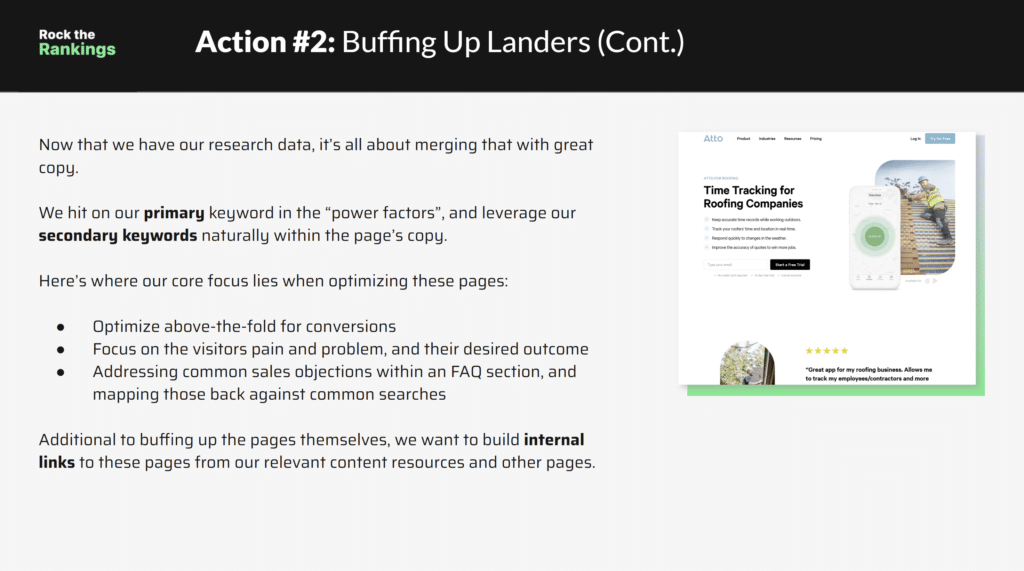
Now, if we dive a little further, right, so we have let’s imagine we have the research, we have everything we need. Okay, well great. In terms of next steps, we want to hit on our primary keyword in our power factors naturally.
So we hit on it in the H one.
We hit on the meta description, the title of the page, we perhaps use it naturally within the content, where it fits and where it happens to come up within the copy.
And the same goes for our secondary keywords.
And where we focus on really optimizing these pages is from a conversion perspective. We want to optimize above the fold for conversions.
We want to focus, as I said earlier, on the visitor’s pain and problem and desired outcome.
And we want to address common Seals objections that we often hear, right, this goes back to the research point. We can actually build that into an FAQ section and then map that back against the way that your users are actually searching as well.
In Google, a lot of times users will have objections in mind after maybe a demo, they’ll go to Google and they’ll actually search those, right, so we can actually rank for those. And even try to dispel some of those objections right, by building that naturally into the page itself.
These are ways that we can buff up the content of the pages and a way that we can actually optimize these pages to target the right terms, the right high-intent terms to actually get them to rank.
The last thing here in terms of buffing up existing landers, we have great copy page structures dialed in. Everything is there. The next thing we want to do is we want to build quality internal links to our product pages.
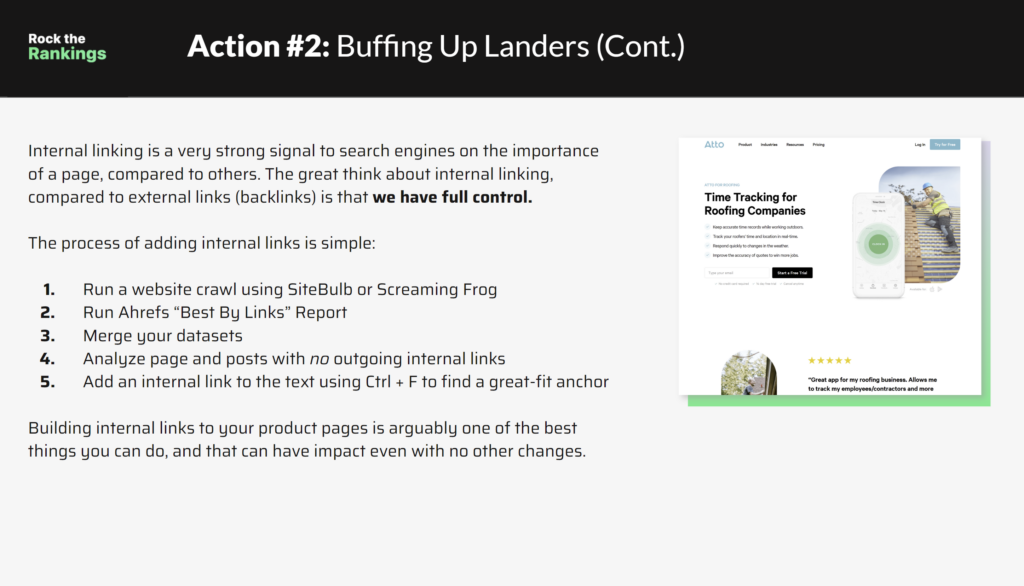
Internal linking is a very strong signal basically around the importance of this page to search engines.
Building internal links is very, very simple using tools such as SiteBulb, or Screaming Frog.
You can also additionally run Href’s Best Buy Links report. Merge those data sets. You can then analyze and see, okay, well, three of our product pages or eleven or 15 of our product pages have zero incoming links.
But what we want to do is go and find relevant content that we have that covers those topics, right?
Further Reading: SaaS Internal Linking
For example, if we have a product page that is specifically built to try and target the term time card app and somebody’s searching for a time card app for their business.
Well, to build internal links from this, we want to build internal links from other content resources that we have that are focused on the theme and topic of timecards.
We have plenty of content resources where we can go.
We can build a contextual link directly to a product page where it’s relevant and where it fits. That’s how we can go and buff these up to pass link value and to help these pages to rank for high-intent terms.
Competitor comparison pages are a great way to drive high-intent traffic directly to you’re already not familiar.
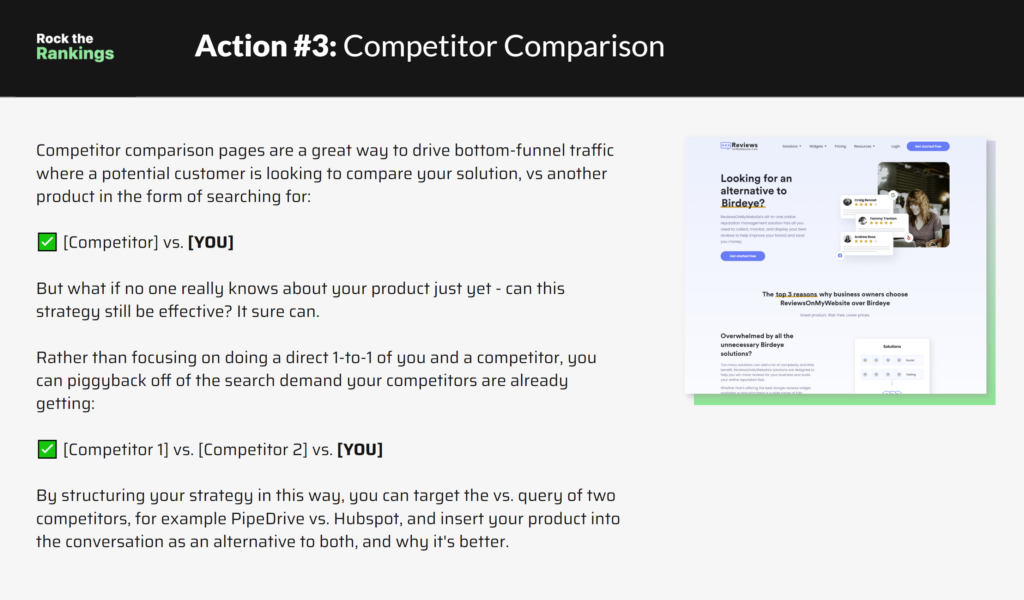
Competitor comparison is basically when somebody is searching and comparing your product to another product, they’re typically closer to the bottom of the funnel.
They’re probably trying to make a purchase decision and they want to learn more information.
They want to get a better idea of what might be the best fit for them from a feature, from a functionality, from a solving a pain perspective.
And if you haven’t already created these pages, you’re going to want to go and actually build these pages to then own and control what others are saying about your product.
Because if three of your competitors have built these pages, and G2, Capterra, and TrustRadius have these pages ranking as well – you’re not doing a very good job at telling a story of why you’re better than the other product.
And trust me, these are extremely valuable pages to have.
And they do very well at actually converting website visitors and prospects into sign-ups, into demos. They’re close to the bottom of the funnel.
So by not having these pages, you’re truly at a disadvantage.
Further Reading: Competitor Comparison Pages
And look, even if you don’t have a lot of awareness just yet around your product, these still totally make sense to create.
So there’s an example I have here on the page, competitor one versus competitor two versus you.
This is essentially a way that you can go and piggyback off the back of people who are searching, comparing two other products, two of your competitors, and inserting your product into the conversation.
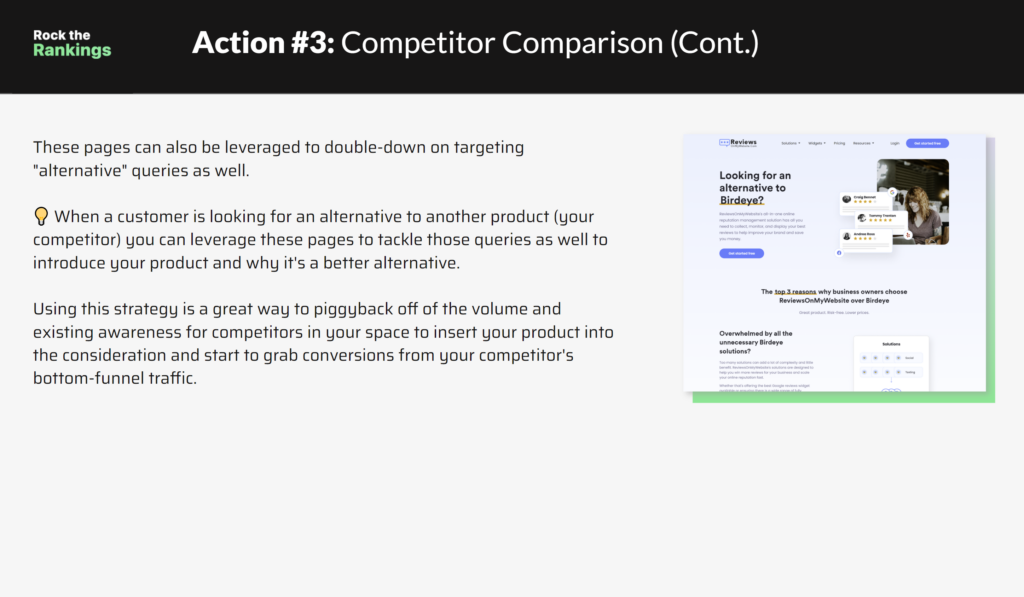
Right here’s a great example of a company called Lancey from Y Combinator.
What they’ve done is they are targeting two of their close competitors.
They’re basically trying to benchmark and compare Walnut versus Reprise.
And you’ll see down here in position one, slowly getting up to the top of position one.
What’s happening is Lancey’s page ranking.
Lancey’s pages ranking where they’re targeting this specific query, walnut versus Reprise. And they’re basically inserting Lancey into the conversation.
So that’s why the strategy can be so powerful, because Lancey doesn’t have a ton of awareness yet just around its brand, around its product.
But we’re able to insert Lancey into the conversation by targeting those two other competitors and by building a comparison of why Lancey is a better fit.
Potentially for that website visitor who’s coming to this page and reading top three reasons why marketers choose Lancey over Walnut reprise a direct one-to-one comparison between the three different platforms.
That is the power of how you can actually use the competitor comparison strategy, even if you have a relatively new product.
Not much brand awareness, right?
This is still very, very powerful stuff.
The other thing I’ll say quickly about competitor comparison is that it also targets and can target alternative queries.
It’s an alternative query is typically when somebody’s currently using a specific product and they’re trying to figure out, well, what are other alternatives out there?
Like what’s another alternative to Walnut?
What’s another alternative to HubSpot or Pipedrive or whatever that might be?
And typically targeting and ranking for the competitor comparison. And the alternative queries can be done on one singular page.
We can tackle this with one single competitor comparison page to try and target both queries.
The final action that we do is we take a look at the existing content base and we basically want to utilize what we already have and improve it.
So going and creating new content constantly is not always the name of the game, especially if you already have a strong content base.
So, as I have here, stop creating new content if you have a ton of existing content.
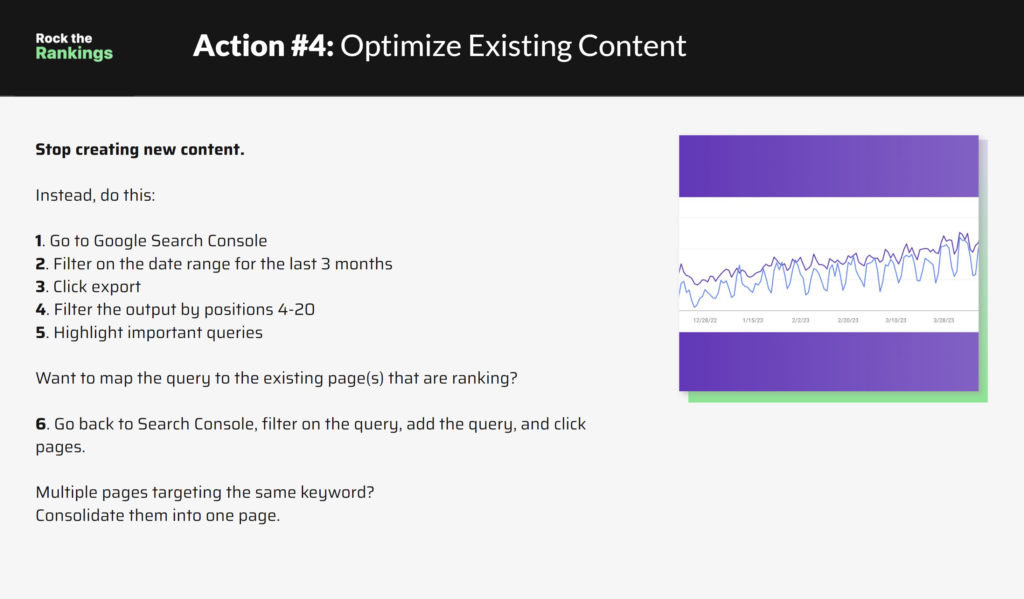
There are certainly tons of gems here where we can basically just figure out how to optimize our existing content and improve it and upgrade it and refresh it to get it to rank higher in the SERPs, to dominate more relevant queries in the SERPs.
What we do is we take Google Search Console data, we filter that down for the last three months and we take a look at – and then I want to export this data into Excel here on the top right.
I have it open in Google Sheets already.
Let me filter on position and show me all of the queries where we’re ranking between position 4 and 20.
Now I have an idea and I can go through and filter down this list and see what are the important queries.
Now, I can merge that with the pages. Where they’re found, and then I can start to take a deeper dive into, okay, well, how do I start to utilize these search terms and queries within that existing content?
How do I go back and add additional search volume to those pages? Google Search Console is the perfect place to start to extract these insights and data.
So you can go and start to create new sections, so you can go and start to dive deeper.
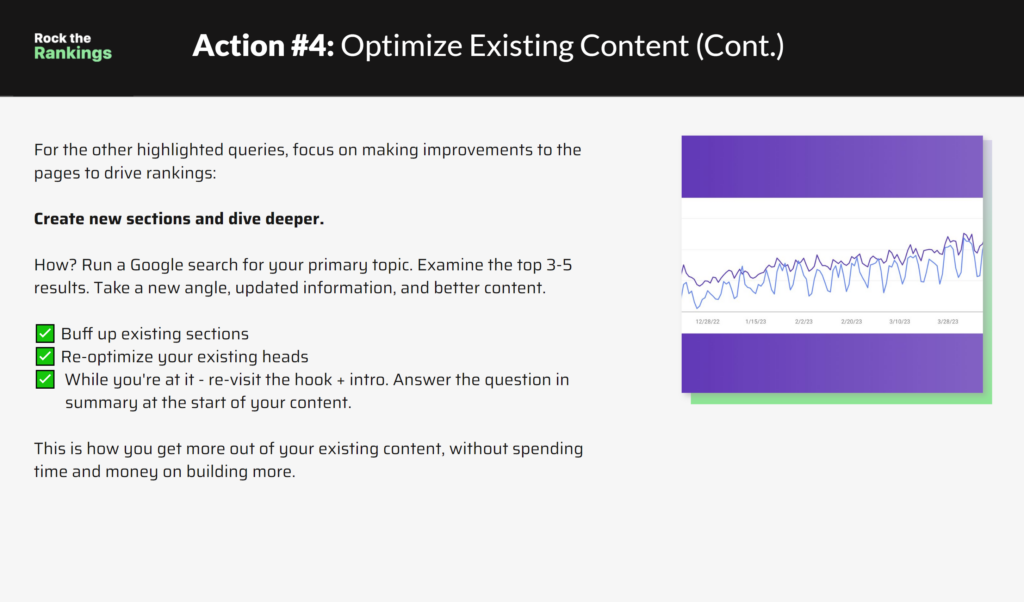
And how we think about that and how we do that is we rerun a SERP analysis, what’s ranking at the top of the current search results, how do we then go and buff up existing sections, add net new sections.
Additional content, additional value.
How do we reoptimize our existing header, title, H1, etc. if we’re not targeting the best primary keyword?
And we also like to go back and revisit the hook.
The hook in the intro is super important.
So many companies create blog content or informational content, whatever that is, and they don’t spend enough time crafting the hook, actually taking the reader in 4-5 concise sentences and engaging with them, and getting them to read further..
We can run with that and get a lot of wins.
And that in and of itself is another huge action item that typically is within our roadmap within the first 90 and the first 120 days.
These are the four core things that we start out with, where we see we get the most lift in performance, the most lift in conversions.
And none of this is focused on link building at this stage, nor net new content.
Focus on these four actions for existing assets, for your existing website, and how you can optimize that for further.
If you start to prioritize these specific actions and work through them, you’ll start to see huge leaps in performance in your organic conversions.
Struggling to further drive quality inbound demos and signups? Not sure what’s the best next step to unlock further organic customer acquisition? We can help.
Book a free consultation below, and we’ll take a look at your current setup, and where you’re trying to go to give you the best path forward for growing conversions and revenue.
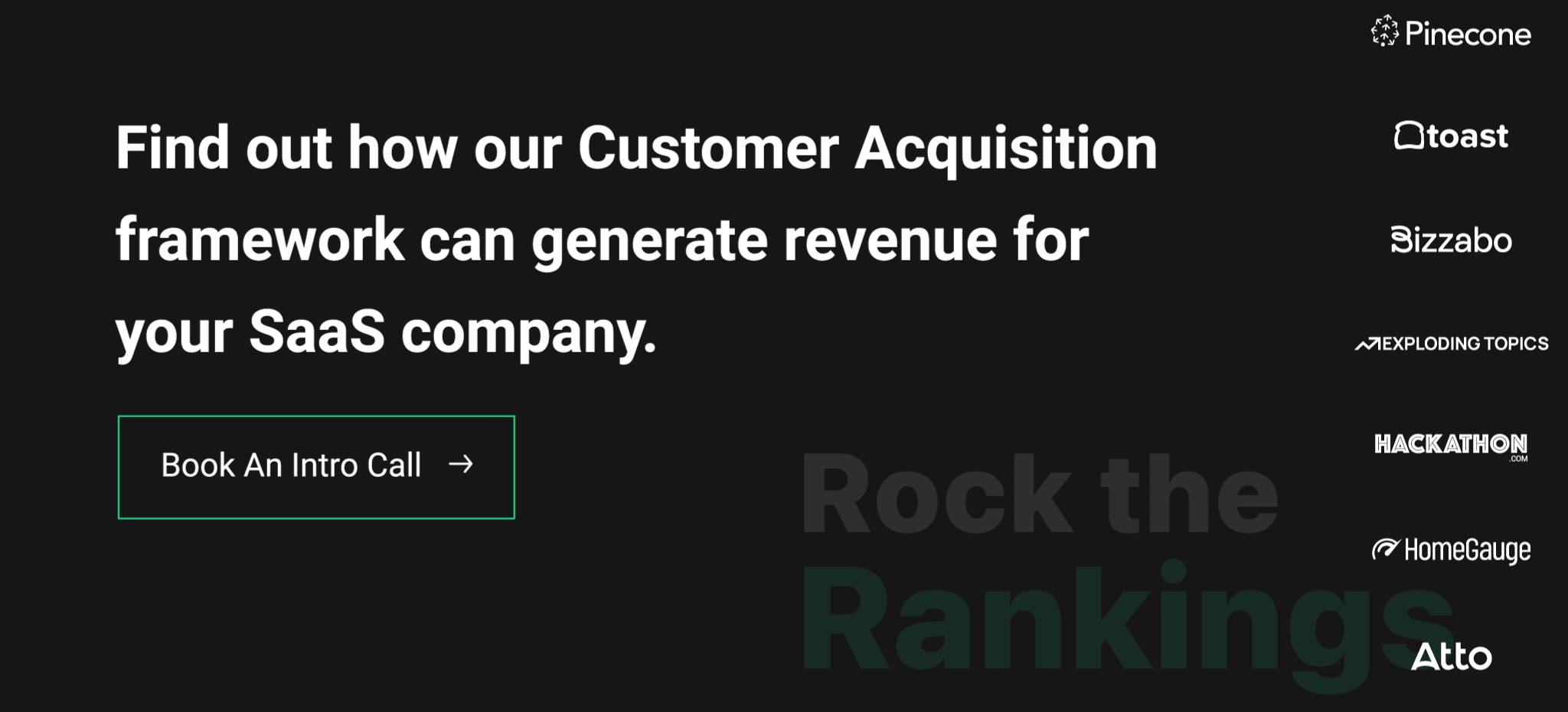
Founder of Rock The Rankings, an SEO partner that helps B2B SaaS brands crush their organic growth goals. An avid fan of tennis, and growing micro-SaaS businesses on the weekend. 2x SaaS Co-Founder – Currently working to build and scale Simple Testimonial.
Book a 1-on-1 intro call with our founder that includes a FREE custom marketing plan. Start growing faster, today.